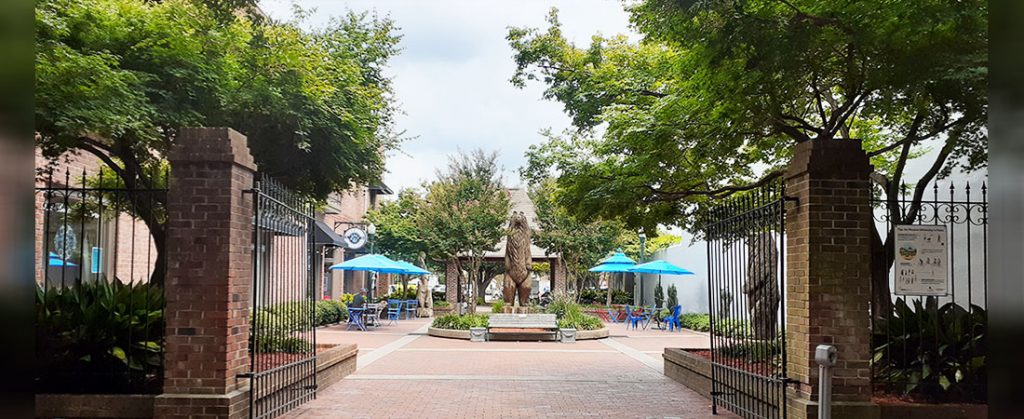
Early planning efforts and long-range strategic plans were key to New Bern’s successful revitalization effort. Over the 40-year downtown revitalization effort, strategic plans created a vision and consensus among community members and guided the decision making for unified public/private development in the downtown and redevelopment of the waterfront.
Located at the confluence of the Trent and Neuse Rivers, New Bern was a major port mercantile center until the early 1900’s. The advent of the automobile, trucking, and improved roads led to the exodus to the suburbs resulting in an abandoned, blighted waterfront and a deteriorated downtown area. Businesses were boarded up, some demolished, leaving gaping holes in the streetscape and the widening of Broad Street, a major Highway 70/17 corridor led to further decline, creating a barrier between the residential area and the downtown business district and commercial waterfront.
In 1968, under the federal urban renewal program, the city created a Redevelopment Commission that acquired and demolished properties on the three-block, 21-acre Trent River waterfront to revitalize the waterfront and the rest of downtown. Seven of the acres were sold in a piecemeal fashion until the mid to late 1970’s when the commission conveyed all the remaining property to the City and county.
In 1977, to address the crisis, a group of visionary businessmen in partnership with local government officials, hired Raleigh firm to develop a downtown revitalization plan (DRP).
The Board of Aldermen (BOA) adopted the DRP in July 1977. It was the catalyst for the revitalization effort which restructured the downtown economy — developed a tourism industry based on the preservation of its historic assets, water-related recreation, and retirees, as their disposable income could be strong assets.
Basic Elements/Recommendations of the 77 Plan
Create a non-profit to lead the revitalization of the downtown and redevelopment of the waterfront in partnership with local government. Private sector involvement was important. The adoption of a general physical development policy consisted of these elements:
-
- Open space plan connecting downtown to the residential area and the urban renewal land.
- Create a Riverwalk along the Neuse and Trent shorelines for public access.
- Create straight streets extending from the downtown thru the urban renewal area to the water’s edge.
- Re-establish the original building facades of the late 1800-early 1900’s architecture.
- Create pedestrian alleyways from mid-block parking (connectivity).
- Enforce sign ordinances.
- Encourage upper second story residential.
- Future projects: Narrow Broad Street, add plantings and underground utilities.
Swiss Bear was established in 1979 and began to implement the 77 Plan’s recommendations. It became a NC Main Street City in 1981 and served as a catalyst to enhance and promote the downtown effort. In the meantime, the initial goals and objectives of the 1977 Plan and Main Street were being put into place and the downtown effort was gaining great momentum and tourism was beginning to grow into a major industry.
By 1988, the initial needs defined in the 77 Plan were addressed and downtown’s progress depended on refining the plan and addressing current issues. Success brought new challenges that demanded workable solutions which led to development of the 1990 Urban Design Plan. It provided the roadmap for achieving incremental, realistic goals and objectives. Highlights of that Plan focused on shared parking, special streetscape treatments, reinforcing and strengthening pedestrian connections, infill in core retail vacant lots, and guidelines for siting buildings and waterfront development.
The 1990 Plan was a catalyst for investment and growth and completion of the priority projects throughout the decade. It led to development of the 2000 Urban Design Plan which focused on improving the gateways into the downtown area, improved housing in the Five Points neighborhoods, and circulation traffic patterns.
The value and importance of developing a new, long-range strategic plan with achievable goals that will guide decision making and attract investment that complements downtown’s “sense of place” can’t be overstated.
The money spent on the 1990 and 2000 Plans ($130,000) leveraged millions of dollars of investment in new construction and rehabilitation: major downtown improvements, a riverwalk, two new bridges, tourism is now a multi-million-dollar annual industry, property values increased 500-900%, thousands of jobs have been created.
Updating or creating a new strategic plan is key to the on-going long-term sustainability of downtown New Bern, and continued growth and development in Craven County.
By Susan Moffat Thomas, retired executive director Swiss Bear

